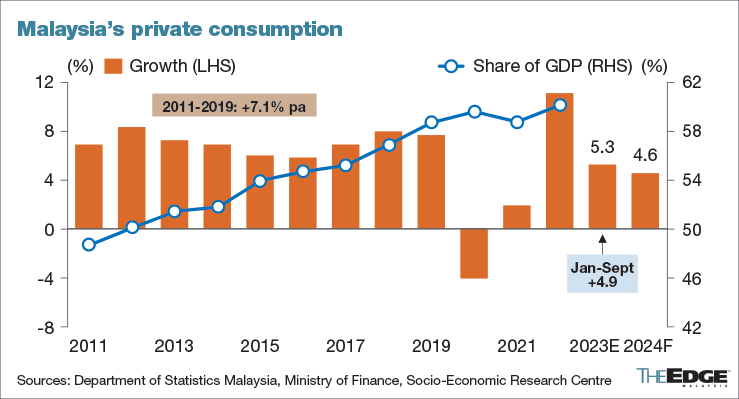
Socio-Economic Research Centre executive director Lee Heng Guie: However, looking at the interest rates alone is not enough [for the ringgit appreciation]. There are also other factors. For example, the government must continue to implement structural reforms to assure investors that Malaysia will be better going forward. (Photo by Patrick Goh/The Edge)
KUALA LUMPUR (Jan 11): The Socio-Economic Research Centre (SERC) has forecasted private consumption to moderate to 4.6% in 2024 from 5.3% in 2023, due to re-emergence of inflation risks, driven by new taxes and targeted subsidy rationalisation which is expected to take place in the second half of the year.
SERC executive director Lee Heng Guie said while the labour market is expected to maintain full employment conditions with an unemployment rate of 3.3% in 2024 and wage is expected to grow by 5%, consumers will remain cautious with their spending, particularly on necessities.
“The gradual targeted subsidy rationalisation and new taxes may impact the [consumer] sentiments, for example [the increase from 6% to 8% in] the service tax. Even though it does not apply to restaurants and food, it applies to some of the logistics, karaoke services, underwriting such as car repairs and insurance.
“You have the low-value goods tax if you purchase items below RM500 online from overseas. There will also be a high-value goods tax of between 5% and 10% starting in May this year, so that will impact the high-end retail market spending,” he said at a media briefing on Malaysia’s Quarterly Economy Tracker (Oct-Dec 2023) and Outlook for 2024.
Nevertheless, SERC remains cautiously optimistic about Malaysia’s economic outlook in 2024 with a forecasted gross domestic product (GDP) growth of 4.5% supported by the continuous growth in domestic demand and a recovery in exports.
This comes within Malaysia’s official forecasted GDP of 4.0% to 5.0% in 2024. For the first nine months of 2023, Malaysia recorded a GDP growth of 3.9%.
SERC said export growth will be supported by a gradual improvement in global demand, a recovery from the downturn in the tech cycle, and an increase in demand for chips for electric vehicles, artificial intelligence and 5G technologies.
Furthermore, the research house has projected an inflation rate of between 2.8% and 3.5% due to subsidy rationalisation, on top of currency risks and uncertainties linked to supply-related factors such as global commodity prices and geopolitical tensions.
Ringgit expected to appreciate against USD, SGD in 2024
On the local currency, SERC has forecasted the ringgit to appreciate to the 4.40 level against the US dollar by the end of 2024.
Lee said the US Federal Reserve will likely cut the federal funds rate to a range of between 4.50% and 4.75% in the second half of 2024, while Bank Negara Malaysia will likely keep the overnight policy rate at 3% throughout the year.
“However, looking at the interest rates alone is not enough [for the ringgit appreciation]. There are also other factors. For example, the government must continue to implement structural reforms to assure investors that Malaysia will be better going forward. There are also prospects on corporate earnings, high-quality investments, job creation and income growth,” he added.
Lee also expects the ringgit to perform better against the Singapore dollar in 2024 after the local currency had depreciated over 10% against the Singapore dollar in 2023.
- Malaysia won’t retaliate, will negotiate with US on tariffs — Miti
- Glovemakers rebound as investors see competitive advantages
- Trump’s tariffs on Asean: Nothing to dread, everything to fear
- Thailand’s richest man picks bad day to debut flagship firm
- Malaysian stocks decline following Trump's reciprocal tariff
- Gas pipeline fire: Decision on temporary housing will be announced by Monday — Amirudin
- Rubber glove makers urge govt to consider emergency support measures amid US tariffs
- Selangor to focus on welfare of gas pipeline fire victims
- Opec+ to advance oil output hike plan, oil drops
- Preliminary findings on gas pipeline fire to be released tomorrow — Selangor MB


